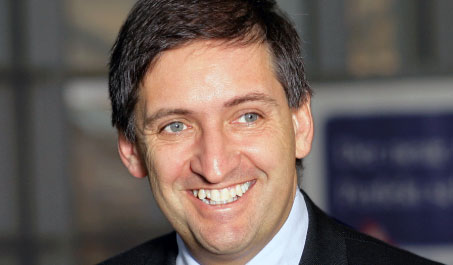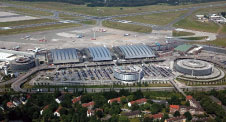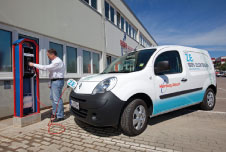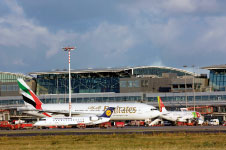
Eggenschwiler: “As well as making sure that everyone who works at the airport is helpful and friendly and smiling – which of course doesn’t cost much but makes such a difference to the passenger experience – we want to make travellers comfortable, make them feel at home, and that’s all over the airport. I think that it’s very important that we achieve this.”
From new technologies to convenience-enhancing initiatives, Hamburg Airport is implementing a multitude of innovations to enhance the passenger experience terminal-wide. In April, it is hosting the ACI EUROPE Airport Trading Conference and Exhibition, which explores ‘Collaboration and innovation to enhance the volume and quality of commercial opportunities for the passenger’, and suitably the largest airport in northern Germany has the needs of the passenger at the very forefront of its operations.
The airport has already received recognition for delivering an exceptional airport journey, having attained ACI EUROPE’s ‘Best Airport Award’ in the 10-25 million-passenger category last year. Michael Eggenschwiler, CEO, explained that the airport’s passenger-focused approach is what earned it the accolade: “We have been working very hard in past years, in all aspects of our customer care. We have always made sure that decisions we make correspond with the wishes of our passengers, and that we are working closely with our airlines, and I think that in itself has been recognised; the comprehensively first-rate approach that we have towards our passengers in all areas of the airport.”
Giving the passenger a voice

Being a considerate neighbour comes high on Hamburg Airport’s agenda. Since last year €11-12 million has been spent on installing noise-reducing windows to residential houses in the surrounding area.
Hamburg Airport has strived to listen to the needs of its passengers and develop its strategy for growth accordingly, and it is now working to maximise the channels of communication between airport and traveller. In the terminal itself, the airport is trialling an innovative system in which access to iPads, placed around passenger areas, allows travellers to give feedback on their experience of the airport and receive an instant response. “For example, if somewhere is not clean they can just type it in there and the right people will get the message, that way they can take immediate action,” Eggenschwiler commented.
The airport is also harnessing its Facebook and Twitter interactivity as a further platform for passengers to express their views. “We’re doing a lot in social media and we’re getting quite a lot of followers. Our Facebook activity is something that to me, as CEO, is a really useful indication of the feedback we get, and also a medium by which to really learn what passengers want,” added Eggenschwiler.
Most recently, the airport has responded by introducing some initiatives that fulfil the needs of the passenger in the terminal. One example, specifically serving the requirements of travellers with young children, is the newly introduced ‘buggy service’, which allows parents to check-in their pushchair and exchange it for a specially-designed buggy that is made slimmer to fit through security lanes. “And when they get to the gate they just leave the buggy there and their own buggy is on the plane already. They get it back as soon as they arrive,” Eggenschwiler explained.
“Additionally, we have installed wireless internet throughout the entire airport that is free for everybody for one hour – that’s being used very strongly. We’ve also got various new seating opportunities that are more relaxed so passengers can feel comfortable if they have a little longer to wait, and we’ve introduced a number of business corners where we provide electricity plugs so that passengers can recharge their phones or use their computers. People requested these things, so we did them.”
The airport’s next step is to implement innovative new baggage technology, including a common use baggage drop-off. Two different systems of automated bag drop are being trialled at the airport in order to test which of the devices is the easiest for passengers to use, prior to its airport-wide installation later in the year.
Growing freight operations

In 2012, Hamburg Airport was given a Green Fleet Award for its sustainably fuelled ground vehicles, which include gas powered baggage handling vehicles, a car that runs on hydrogen and several types of electrically fuelled ground transport.
Though its 1% year-on-year growth in 2012 fell slightly short of the airport’s 14 million passenger-target, Hamburg Airport overcame severe drawbacks last year, including the effects of the German Flight Tax on the domestic market and the financial difficulties that faced the airport’s second largest carrier, Air Berlin, which brought about a tough restructuring programme on its flight network. “At the moment we have slightly less movements than the year before – about 3.5% less flights – meaning we’re seeing about 150,000 movements annually,” commented Eggenschwiler. “We’re seeing a trend at the moment towards larger aircraft, and especially the number of passengers per flight, which increased to 104 passengers per flight on average – +4.4% on the previous year.”
It is expected that the number of air traffic movements will remain steady throughout this year. In February, bmi regional opened the first service between Hamburg and Bristol since 2009, while easyJet added an Edinburgh service in March. “We’ll also be handling new flights to Pula in Croatia, and a Vueling flight from Florence, Italy,” said Eggenschwiler.
Vueling will also open a route to Málaga in June. Eggenschwiler expects passenger numbers to grow by another 1% in 2013, meaning the airport will handle just less than its 14 million-passenger goal.
The airport is also enhancing its freight activities in accordance with the anticipated growth in air cargo in the metropolitan region of Hamburg, and is currently beginning the construction of a new cargo centre, which will replace the current facility when completed in 2015. Planning has begun for the construction of 20,000sqm of cargo services and 6,000sqm of facilities that will expedite the airport’s ability to handle its growing freight operations. The facility will occupy the space that is currently the airport’s Holiday Car Park, and in turn, building has begun on a new 2,800-space car park, the largest the airport has seen.
Hamburg Airport is Airport Carbon Accredited at the ‘Reduction’ level, and it is focusing on implementing airport vehicles that run on renewable energies. In 2012 it was presented with the Green Fleet Award for environmental innovations in its ground handling vehicles, many of which are powered by electricity, gas and hydrogen.

Significant expansion of the airport’s route network is taking place in early 2013, including a new service to Pula, an easyJet service to Edinburgh, and Vueling routes to Florence and Málaga.
A 14-person department dedicated to making the airport’s operations as sustainable as possible has also worked hard in recent years to save energy within airport buildings, preserve air quality in the airport surroundings, and reduce noise.
“We make sure that we do a lot to support our neighbours. All of our operations are transparent – they can look everything we do up on the internet – and last year we started a programme to invest €11-12 million in the introduction of soundproof windows to houses in our neighbourhood. More than 15,000 houses and apartments have received such windows in the past year, and in total 20,000 houses will receive new windows to make sure that we protect them from noise as well as we can,” concluded Eggenschwiler.







